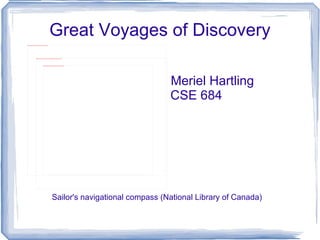
Hartling clickthroughpresentation
- 1. Great Voyages of Discovery file:///home/pptfactory/temp/20120408183241/220px-Compass_thumbnail.jpg file:///home/pptfactory/temp/20120408183241/powerpointpictures/220px-Compass_thumbnail.jpg file:///home/pptfactory/temp/20120408183241/220px-Compass_thumbnail.jpg Meriel Hartling CSE 684 Sailor's navigational compass (National Library of Canada)
- 2. A spirit of adventure swept across Europe in the 1400s. file:///home/pptfactory/temp/20120408183241/powerpointpictures/220px-Christopher_Columbus_on_Santa_Maria_in_1492..jpg file:///home/pptfactory/temp/20120408183241/220px-Christopher_Columbus_on_Santa_Maria_in_1492..jpg Explorers like Columbus file:///home/pptfactory/temp/20120408183241/220px-Christopher_Columbus_on_Santa_Maria_in_1492..jpg and Magellan set to find new sea-routes, lands and riches. What motivated these voyages? Columbus on Santa Maria by Emanuel Leutze 1855 How did they impact on both Europe and the peoples of the “new” worlds they unveiled?
- 3. In this lesson, we will consider... Motivations behind voyages Means which made the journeys possible Spanish and Portuguese explorations of Da Gama, Columbus and Magellan Spanish conquest of the new world Competition between European powers
- 4. file:///home/pptfactory/temp/20120408183241/spice_route.gif Motivation behind voyages file:///home/pptfactory/temp/20120408183241/powerpointpictures/silkroad.gif Traditional Silk and Spice Routes to Aisa Italian, Egyptian and Turkish control of trade routes to Asia meant new direct sea-routes were desired. The wish to spread Christianity also played a role.
- 5. Update Motivations behind voyages Means which made the journeys possible Spanish and Portuguese explorations of Da Gama, Columbus and Magellan Spanish conquest of the new world Competition between European powers
- 6. Means behind the voyages file:///home/pptfactory/temp/20120408183241/powerpointpictures/220px-Persian_astrolabe.jpg file:///home/pptfactory/temp/20120408183241/powerpointpictures/DownloadedFile.jpeg file:///home/pptfactory/temp/20120408183241/220px-Persian_astrolabe.jpg file:///home/pptfactory/temp/20120408183241/images.jpeg Astrolabe and compass New technological developments such as the astrolabe (for measuring star positions), the magnetic compass and developments in ship building paved the way for ocean voyages.
- 7. Update Motivations behind voyages Means which made the journeys possible Spanish and Portuguese explorations of Da Gama, Columbus and Magellan Spanish conquest of the new world Competition between European powers
- 8. Portuguese and Spanish Explorations In 1498 Vasco da Gama sailed around Africa and landed on the West Coast of India. Thus a direct sea route to Aisa was found. file:///home/pptfactory/temp/20120408183241/powerpointpictures/220px-Vasco-da-gama-2.jpg file:///home/pptfactory/temp/20120408183241/220px-Vasco-da-gama-2.jpg
- 9. In 1492, an Italian sailor, Christopher Columbus sailed west. It was well known amongst seafarers that the Earth was round and so Columbus hoped to find a direct route to Asia. Instead he landed in the what we now call the Bahamas. file:///home/pptfactory/temp/20120408183241/powerpointpictures/columbuvoyage.jpeg
- 10. file:///home/pptfactory/temp/20120408183241/powerpointpictures/magellan.jpeg file:///home/pptfactory/temp/20120408183241/images.jpeg In 1519, a Portuguese sailor named Ferdinand Magellan accidentally discovered South America while trying to sail around Africa. He continued West and although was killed during the voyage, his crew became the first to circumnavigate (go all the way round) the globe.
- 11. Update Motivations behind voyages Means which made the journeys possible Spanish and Portuguese explorations of Da Gama, Columbus and Magellan Spanish conquest of the new world Competition between European powers
- 12. Conquest of the New World file:///home/pptfactory/temp/20120408183241/powerpointpictures/Inca.jpeg In the 1500s the Aztec empire in Mexico and the Inca empire in Peru were at their zenith. The Spanish saw these as great sources of gold and silver. With the added motivation of religious conversion they set out to conquer. The remains of the Inca city of Machu Pichu in Peru
- 13. Why did the Spanish conquests succeed? Guns: Gunpowder had not reached the Americas. Cavalry: The Americans had no horses and had no knowledge of riding an animal. Steel weapons: The American weapons (usually made of obsidian) were no match for Spanish steel. Germs: diseases like smallpox wiped out huge numbers of Americans who had no previous exposure to these European diseases.
- 14. Update Motivations behind voyages Means which made the journeys possible Spanish and Portuguese explorations of Da Gama, Columbus and Magellan Spanish conquest of the new world Competition between European powers
- 15. Competition for treasure file:///home/pptfactory/temp/20120408183241/powerpointpictures/armada.jpeg England and France soon joined the race to carve up the new world. Competitio for the wealth led Spain in 1588 to send an enormou fleet (the armada) to attac England. But faster Englis ships and better guns defeated the Spanish. The Spanish Armada (English School 1600)
- 16. Update Motivations behind voyages Means which made the journeys possible Spanish and Portuguese explorations of Da Gama, Columbus and Magellan Spanish conquest of the new world Competition between European powers
- 17. Conclusion: A new European Worldview. The voyages of discovery changed the way Europeans saw the world. They learned that the Americas were a separate landmass from Asia. Many saw this as a source of great wealth and set up trade networks and began to establish colonies. This would have wide ranging consequences.
- 18. Summary The voyages were motivated by a need for new routes to Asia. They were made possible by new technology: compass, astrolabe, better ships. Da Gama discovered a new route to India by sailing around Africa. Columbus discovered a route to the Caribbean islands unveiling the continent of North America. Magellan discovered South America before his crew rounded the globe. Better technology and resistance to disease helped the Spanish conquer the new world. Greed for treasure led to competition between European powers like Spain and England.
- 19. References Text based on World History by Burskein and Shek All graphics come from Wikipedia.